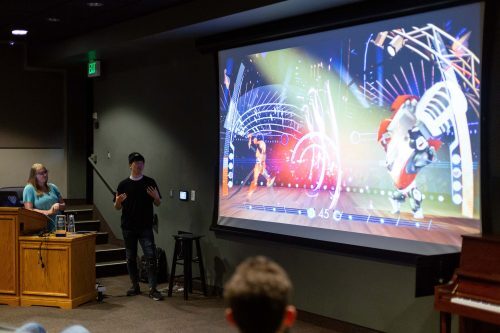Student organizers Jessica Runyan and Jared Richardson discuss their symposium experience
Student organizers Jessica Runyan and Jared Richardson discuss their symposium experience

Jessica Runyan and animation student Do Park present BYU’s award-winning game “Beat Boxers.” (Alyssa Lyman)
New media forms such as social networking platforms, virtual reality and digital games regularly spark research and warnings about potential hazards, but a recent BYU symposium explored the other side of the coin: emerging media and creative collaboration as a force for positive change.
The Media of Today and Tomorrow symposium was organized by Department of Theatre and Media Arts professor Benjamin Thevenin in collaboration with media arts students Jessica Runyan and Jared Richardson. The team put together a full day of panels, workshops and interactive displays in the hopes of connecting students with like-minded individuals and professionals in various sectors of new media.
“One of the first things we talked about was what we wanted our message and the feel of the symposium to be,” said Runyan, who is interested in producing and developing video games. “We wanted to capture this idea of a world’s fair where people who work in new media can get together and network. The main goal was to create opportunities for students to connect with people both on and off campus and see what other projects are going on that they could get involved in.”
As part of this mission, the organizers reached beyond film and animation to invite different disciplines across campus — including journalism, psychology, family life and computer science — all of which, Runyan explained, contribute important perspectives on both the perils and promise of new media.
Kimball Jensen (left) moderates a discussion between Mike Rugnetta, Mallory Everton, Curtis Hickman and Myke Johnson. (Alyssa Lyman)

The symposium’s midday panel also brought together a variety of skills and interests from across the industry. Theatre and media arts professor Kimball Jensen moderated a discussion between PBS Idea Channel creator Mike Rugnetta, Studio C and JK Studios writer and actress Mallory Everton, The VOID co-founder Curtis Hickman and Spy Hop audio instructor Myke Johnson.
“Each member of the panel came from a very different background, but the principles they were sharing about creativity and collaboration were the same,” said Richardson. “New media can seem disparate, but whether you’re making a film or a video game, there’s so many things we have in common. I think the best thing to come from the panel and other presentations throughout the day was how much potential there is in all of these things.”
Mike Rugnetta also delivered the keynote presentation, focusing on the use of new media as a tool for creators to connect with each other and build a better world.
“He didn’t shy away from the hard issues,” said Runyan. “He talked about how a lot of the problems we’re dealing with online aren’t specifically internet problems; they’re real-world problems that involve the internet.”
Environmental science student Neal Butler tries out a VR project as part of a session organized by BYU’s Mixed Reality Lab. (Alyssa Lyman)

In both his address and the Q&A that followed, Rugnetta offered advice and options for combating negativity online.
“The best way is not necessarily to try to make media to attack someone else, but to make another option,” said Runyan. “He talked about how hard it is to create a piece of media that attacks somebody else’s view in a way that is also uplifting. Instead, we can make media that is a better opportunity or a better choice for people. There are issues that I can’t solve on my own, but I can create a positive community online that people can choose to click on instead of something else.”
Richardson, who plans to pursue a career in post-production sound and children’s media, appreciated the weight Rugnetta placed on parts of the industry that are often dismissed as trivial or pointless.
“It’s very clear that he’s taking things like gifs and memes and YouTube videos very seriously, and I think we all need to do that,” said Richardson. “New media is so important. It took time for film to be considered an art form, and for some reason it’s still taking people a while to realize that things like internet culture and video games absolutely have artistic merit and can be used to great effect — whether that be for good or for a detrimental effect.”
Attendees young and old design Ninendo Labo battle bots from cardboard. (Alyssa Lyman)

Both Richardson and Runyan came away from the symposium with a greater understanding of the impact their attitude and intent have on the things they create.
“The same principles apply to all new media work,” said Runyan. “Be nice to people, be nice to yourself and realize that you can’t do everything. You can go into whatever kind of field you want, but at the end of the day, you have to ask yourself, ‘maybe I have the technical skills, but am I nice to people? Can I be reliable? Can I be a good force in the industry?’”
In addition to presenting on YouTube gamers in a breakout session, Richardson headed up an interactive Nintendo Labo display. Watching symposium attendees build their own cardboard creations to interact with the Nintendo Switch reminded him that imagination, innovation and positive entertainment remain at the heart of much of new media.
“New media is fun, and we need more fun,” said Richardson. “We also need to broaden our horizons — this isn’t just for film students. Anyone can come and participate and get excited about the future.”